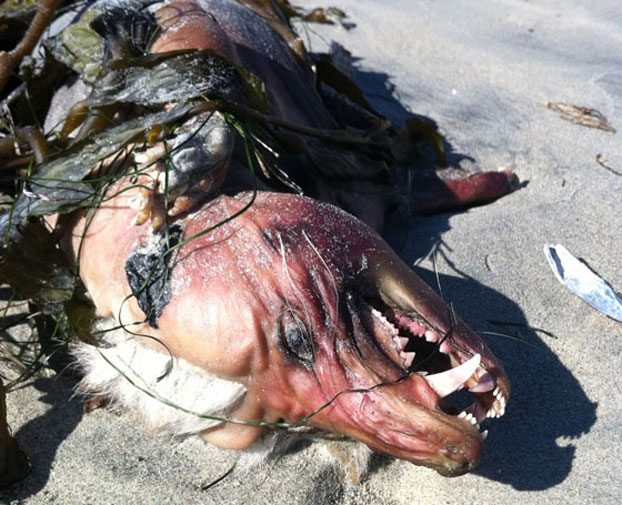He’s got a bleach-blonde mohawk, sunburned skin, and a pair of really vicious-looking fangs. And don’t even ask about the body odor, which is bad enough to draw flies. But don’t worry, he (or she) is dead. (Though, like all movie monsters, it might come back to life at the last moment, setting up a sequel.)
Photos of the 24-inch animal carcass were taken last week by a 19-year-old snowboarder visiting San Diego’s Pacific Beach. He showed them to a friend, who passed it along to another friend, who e-mailed them to Rocco Castoro of the Vice.com blog with the subject line: “Chupacabra/Montauk Monster-looking creature.”
As Castoro noted,
The Ten Commandments of the Internet dictate that anyone who receives images of a “monster” is obligated to disseminate and investigate them, even though incidents like this seem to happen about once a year these days. This one apparently turned up on Pacific Beach in San Diego last week.” Castoro spoke to the man who found it, and the surfer dude “sounded sincere and naive enough (i.e. like Jeff Spicoli) to convince me that he undoubtedly believes this thing was, at one time, a living and breathing mutant hellbeast, or at the very least a member of the aforementioned Chupacabra genus. He also told me it was about two feet in length, and that ‘it had the body shape of a pig—kind of a fat stomach, middle area. And the canines were just ridiculously large…. I didn’t know if it was some creature from around here. I’m from Massachusetts and I don’t see [stuff] like that ever.’”Photos of the strange animal (since dubbed the San Diego Demonoid) spread around the Web; some agreed with the speculation that it was the carcass of a chupacabra, apparently unaware that the mystery of that Hispanic vampire beast was solved last year. Indeed it resembled several so-called “Montauk Monsters”—bizarre, nearly hairless, fanged creatures, one of which first washed ashore in Montauk, New York, in 2008. As usual public speculation ran wild. Some were convinced it was the result of top-secret government experiments; others thought it was a hoax or a chupacabra. In fact the “Montauk Monsters” turned out to be nothing more bizarre than ordinary (albeit decaying) raccoons.
However scientists who have examined images of the San Diego Demonoid don’t think it’s a raccoon but instead a marsupial commonly known as an opossum. Darren Naish, a science writer and paleozoologist based at the University of Southampton who writes the Tetrapod Zoology blog forScientific American, identified it as a Virginia Opossum. “The opposum identity is obvious,” Naish told Discovery News.
PHOTOS: Sea Monsters Real and Imagined
“It’s a mammal with a long, rat-like snout, a rather high number of small incisors, closely spaced premolars with pointed cusps, and especially long, curved upper canines. Note that, unlike dogs, foxes and so on, it doesn’t have an obvious rhinarium (the area of dark, distinctly textured skin that surrounds the nostrils in such animals). These features all immediately screamed “opossum” to me. Partly this is because I’ve handled opossum skulls and am familiar with their surprisingly big upper canines and high number of incisors. Even the fur looks opossum-like (mammal carcasses typically slough fur after they’ve been decomposing in water for a while, and this explains the naked face). When you add all this to the fact that the Virginia opossum is a common, widespread mammal in California we have an obvious and uncontroversial identification.”
It’s not surprising that people have difficulty identifying these decaying carcasses. After all, when we see raccoons and other small mammals they are typically alive, healthy, and fur-covered. Of course, people love mysteries — and as the case of the San Diego Demonoid shows — all it takes to create a mystery is someone not knowing what they’re seeing. More monsters will surely wash up, and so the (temporary) mysteries will continue.
PHOTO CREDITS: Josh Menard
Source

